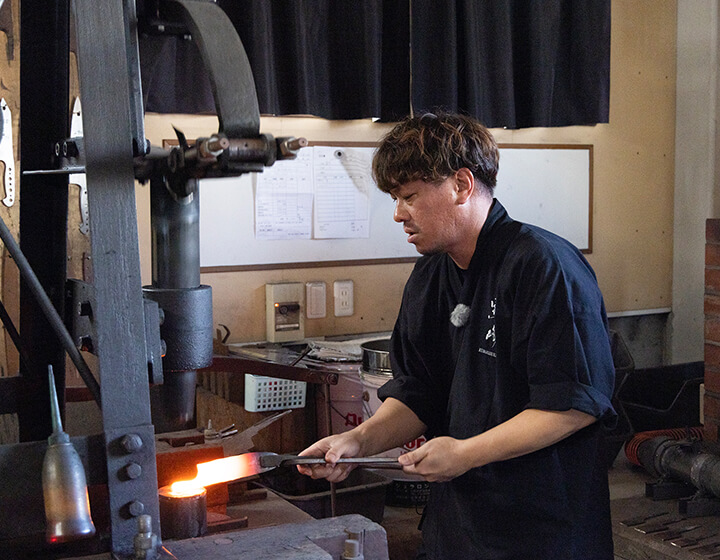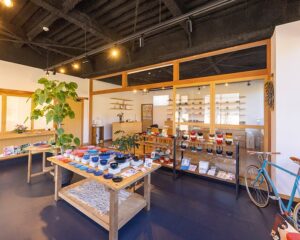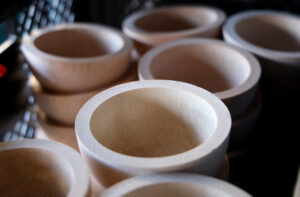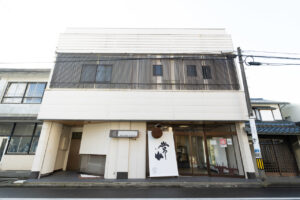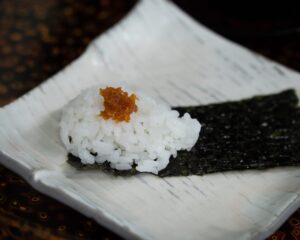Echizen hammered blades are said to have a history of about 700 years. It became a specialty of the Echizen City area, once called Echizen Province, and was protected by the Fukui Domain during the Edo period, and in 1970 it was designated as a traditional craft for the first time in Japan. In this rare production area, Masaru Kurosaki is a blacksmith who attracts the world with his knives that combine outstanding sharpness, lightness, durability, and beautiful design.
10,000 knives were reserved, and a three-year waiting list was required.
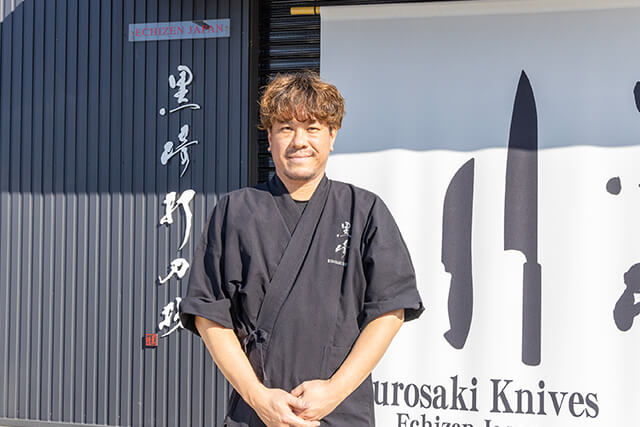
Echizen Uchihamono is produced in Echizen City, located in the center of Fukui Prefecture, about 10 minutes by car east of the nearest JR Takefu Station in Ikeizumi Town, which is also close to the production center of Echizen washi paper. In recent years, Echizen hammered blades have been highly acclaimed by chefs in Japan and abroad for their modern design and sharpness, but there was a time when the industry was on the verge of serious decline. The “Takefu Knife Village,” completed in 1993, saved the company from this crisis.
The “Takefu Knife Village” has continued to operate as a revolutionary joint workshop where blacksmiths cooperate with each other and nurture their successors. It is now jointly operated by 13 cutlery companies, and in addition to the 40 or so blacksmiths who work together, there is also a direct sales center and a cooperative association. Yu Kurosaki, who became an independent craftsman after completing his apprenticeship here, is now a world-renowned master craftsman of hammered blades.
Kurosaki has his own workshop and store, Kurosaki Uchihamono, next to Takefu Knife Village. The knives produced by Mr. Kurosaki in his workshop have attracted a great deal of attention and are so popular that he has received approximately 10,000 reservations from users around the world, including top chefs in every genre of cuisine, such as Japanese, French, and Spanish, with a three-year waiting list before they are delivered.
Attracting Top Chefs from Japan and Abroad
Mr. Kurosaki receives many offers from overseas to come to Japan and give demonstrations. He has coordinated with trading companies to give sharpening demonstrations in European countries such as Paris, France, Sweden, Germany, Switzerland, and the Netherlands, as well as in Calgary, Canada, where he demonstrated tapping and forging blades, and in New York, USA, where he exhibited at an exhibition.
In meeting with overseas chefs and other users, he was asked for “lightness” and “design” when he held the knives. Mr. Kurosaki has applied what he learned to his own knife making, and orders have been pouring in, with overseas orders now accounting for 80% of all orders. Chefs from all over the world, including the United States, Canada, Europe, and even South Africa, visit Mr. Kurosaki’s workshop to observe his work.
Of course, Michelin-starred chefs of Japanese cuisine, sushi, French cuisine, and so on are waiting for Mr. Kurosaki’s knives in Japan.
Thin, sharp, and durable kitchen knives
Why are the knives produced by Mr. Kurosaki so highly regarded by top chefs? It is simple,” says Mr. Kurosaki. They are thin, sharp, and durable,” Kurosaki says.
Double-edged Western-style kitchen knives are generally thicker than single-edged Japanese-style knives, but Mr. Kurosaki’s double-edged knives are made to be as thin as possible, making them light, sharp, and fatigue-free for chefs. Furthermore, using traditional Echizen Uchihamono techniques not found in other production centers, the blade edge is rounded like a clam to prevent blade spillage.
Although the ultimate thinness of the blade and its strength are normally contradictory, Mr. Kurosaki produces knives that are both thin and strong through forging, a process in which the blade is thoroughly tempered to increase its strength.
Forging” is a process in which metal is beaten to increase its strength. The name “forging” refers to the process of “forging to create.
Echizen forged knives are made strong in the tradition of Echizen hammered blades.

Most kitchen knives used in the home are generally made from steel or stainless steel sheets that are passed through a large machine to the appropriate thickness, and then punched out into the shape of a kitchen knife. This type of knife can be mass-produced efficiently and at a reasonable price.
On the other hand, Kurosaki Uchihamono forges each knife by purchasing the highest quality steel, which is made by laminating the base metal steel with stainless steel for the blade, from a local metal manufacturer. The steel is heated to about 800 degrees in a furnace, and the forging process is repeated to make the metal structure uniform and create a strong blade. At this point, they make full use of a technique unique to Echizen hammered blades called “Nippai Haki” ( two-ply spreading). The “Ni-Haihatsu” is a process in which two blades are heated while stacked on top of each other and struck from the front and back with a belt hammer. The overlapping of the two blades doubles the thickness of the blade, making it harder for the temperature to drop and the force of the belt hammer to be transmitted properly, making it easier to stretch the steel. This results in a blade that is thinner than a single piece. The blade is then coated with mud, heated, quickly cooled with water, and sharpened.
Beauty like jewelry
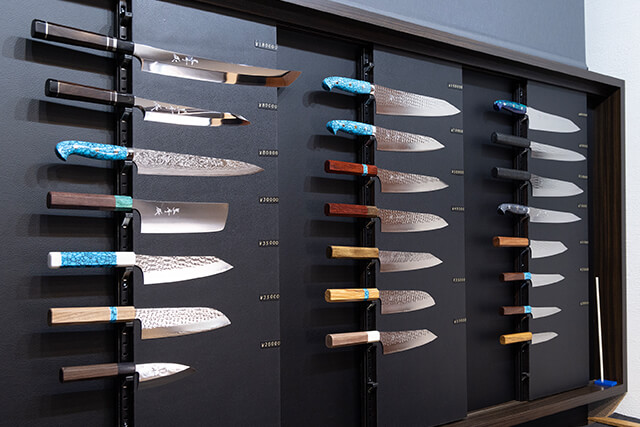
The beauty of Kurosaki Uchihamono’s knives is also a major feature of its products, and the one-of-a-kind design of Mr. Kurosaki’s knives is sure to attract chefs from all over the world.
Mr. Kurosaki creates a “tsuchime” pattern on the side of his knives. The “tsuchime” is a pattern created by tapping the surface of the knife, and Mr. Kurosaki was the first to incorporate the “tsuchime” pattern into a kitchen knife. After thousands of prototypes, he created five original designs: “Shizuku,” “Fujin,” “Raijin,” “Jyugyo,” and “Senko. For the handle material, turquoise is used in addition to natural wood, and combined with “hammered” wood, the result is a beautiful knife that looks like a piece of jewelry.
Mr. Kurosaki was certified as a traditional craftsman in 2019. While he is committed to carrying on the traditions of the Echizen hammered cutlery production area, he dares to focus on the “present” rather than tradition in his own knife making. He has cultivated an eye for what is required in this modern age through his own efforts to become independent after undergoing rigorous training, and to venture out into the world on his own.
To create a new history of Echizen hammered blades

Mr. Kurosaki, who is now attracting attention from around the world, first encountered knife making when he was 22 years old and moving from job to job, when he happened to find a job offer for a kitchen knife smith. At first, he went to visit the workshop and the master showed him his work. The fire in the furnace burning fiercely, the craftsman pounding the iron…. After experiencing the knife-making process, Mr. Kurosaki felt strongly that it was “cool,” and immediately started working at the company the next day.
Encounter with knife making
Mr. Kurosaki, who had “never lasted long in anything he did before,” worked under his master for 12 years.
It was dirty, noisy, hot, and scalding. It was dirty, noisy, hot, and scalding, and the master would get angry easily. But I could get through it. I liked manufacturing and found it interesting.
After gaining experience under his master, Kurosaki began to think, “I want to use this technique as a weapon to become famous and go global. A breakthrough came from a trading company that had been paying attention to Mr. Kurosaki. When Mr. Kurosaki brought his knives to a knife store in Canada, the first order was for only six knives, but from there, the reputation of Mr. Kurosaki’s knives slowly spread on SNS, and orders from overseas began to pour in. Following the recommendation of his master who saw this, he founded Kurosaki Uchihamono in 2014, and the following year, the workshop was completed. It was the first time in 40 years in the production area that the company became independent in a new workshop rather than being taken over.
Training people in a modern workshop
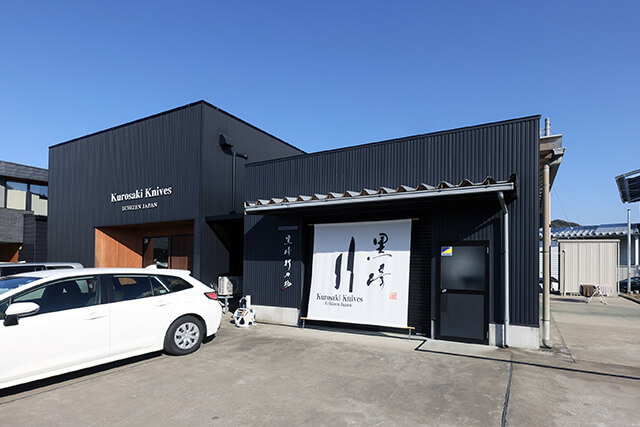
The workshop of Kurosaki Uchihamono is well organized and thoroughly cleaned every day, so it is spotless. I think it is the cleanest workshop in the world,” Kurosaki says proudly. The same rational and modern thinking that cleanliness makes good work possible also applies to the training of younger workers.
I don’t like to be angry with young people. I want to improve together.” Under Kurosaki’s supervision, two young apprentices are honing their skills. Mr. Kurosaki posted a job offer at the “Knife Village” cooperative, and among the applicants, he hired two people from outside the prefecture who “didn’t know who he was. The two apprentices are now mainly in charge of sharpening, and will spend the next 10 years or more in training.
Going global with his apprentices
Mr. Kurosaki encourages his apprentices to create their own works of art in their spare time. The Kurosaki Uchihamono workshop is located next to the Takefu Knife Village, making it possible for apprentices to learn from other blacksmiths and to interact with other apprentices. Kurosaki says, “I want my apprentices to become traditional craftsmen while taking advantage of the environment, and I want us to go around the world together.
A new workshop is currently under construction next door to the studio, scheduled for completion in May 2023.
We are planning to take on another apprentice at the new studio,” Kurosaki said. But I don’t plan to make it too large. I want to work with my apprentices in a spacious workshop.
Mr. Kurosaki’s current goal is to create a high-end line of kitchen knives that will receive even higher acclaim. If we can create satisfactory products in an environment that we are satisfied with, the value of Kurosaki Uchihamono will increase even more. Mr. Kurosaki’s challenge is framed by a newness that cannot be contained by the word “tradition,” as he says with a wry smile, “Continuing to produce kitchen knives that are sought after around the world in the Echizen region will be a source of pride for the entire region and an important asset to be passed down to the future.



